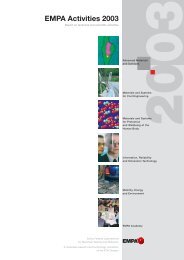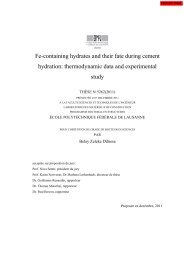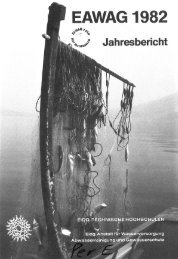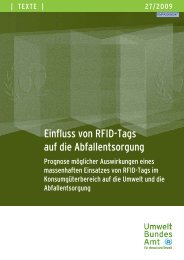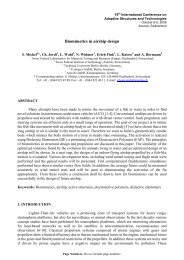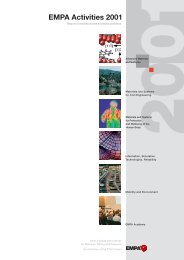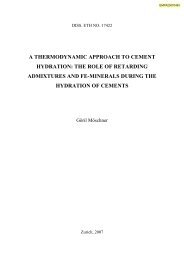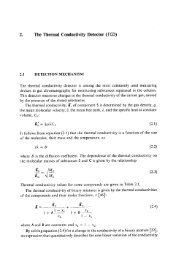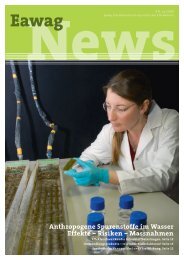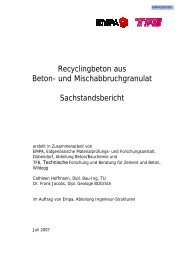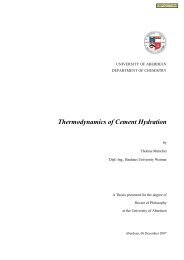THE ROLE OF FABRICS IN TENSAIRITY - Eawag-Empa Library
THE ROLE OF FABRICS IN TENSAIRITY - Eawag-Empa Library
THE ROLE OF FABRICS IN TENSAIRITY - Eawag-Empa Library
Create successful ePaper yourself
Turn your PDF publications into a flip-book with our unique Google optimized e-Paper software.
To strengthen the research of Tensairity structures is the main focus of the recently founded Center for<br />
Synergetic Structures, a private public partnership between <strong>Empa</strong> and prospective concepts/Festo. For<br />
this purpose, new test facilities will be set up at <strong>Empa</strong> to study the behavior of Tensairity structures.<br />
These studies will help to deepen the understanding of Tensairity and to further optimize the<br />
technology and its applications. A special focus will be set on the mechanical characterization of the<br />
fabrics, as the fabric with its non-linear material behavior is a relevant part of Tensairity.<br />
Important properties of Tensairity are shown in Figure 2. Each property is related to the underlying<br />
airbeam or cable-strut structure, where it is inherited from. Little weight and small transport volume are<br />
properties of both the pneumatic structure and the cable-strut structure. The capacity to carry heavy<br />
loads goes back to the cable-strut structure, while fast set up, the temporary nature, thermal insulation,<br />
lighting options, adaptiveness and so on do have their roots in the pneumatic structure. The low air<br />
pressure is an emergent property of the combination of both structures and therefore shown with<br />
dashed arrows.<br />
pneumatic<br />
structure<br />
Tensairity ®<br />
Tensairity ®<br />
Tensairity ®<br />
- light weight<br />
- heavy loads<br />
-low pressure (~100 mbar)<br />
- small transport volume<br />
- fast setup<br />
-temporary<br />
- thermal insulation<br />
- transparency<br />
- lighting<br />
-floating<br />
- adaptable<br />
-safe<br />
Figure 2. Properties of Tensairity, a synergetic combination of a pneumatic structure with a cable-strut<br />
structure.<br />
An important issue is the safety of Tensairity. The vulnerability of the airbeam is an undesired property<br />
of Tensairity taken over by the pneumatic structure. An injury of the hull of a pneumatic structure leads<br />
to a loss of air and the resulting drop of the air pressure endangers the integrity of the structure. The<br />
situation is different in Tensairity due to an inherited property of the cable-strut structure. The struts or<br />
chords in Tensairity have a resulting bending stiffness. They can be designed such that the dead load of<br />
the structure is carried by the chords without the need of the stabilisation of the airbeam. The air<br />
pressure is needed for sustaining the additional live loads [2]. In a lightweight Tensairity structure as<br />
the roof over the parking garage in Montreux, the live load is roughly ten times higher than the dead<br />
load. Stabilization by the over pressure is crucial for the live load, but the integrity of the structure is<br />
not jeopardized with zero pressure solely under dead load. It also enables a pressure release in a<br />
Tensairity structure when e.g. people have to enter the airbeam for service reasons. In structures like<br />
the roof in Montreux high live load events are rare. The risk of a complete air loss in a Tensairity girder<br />
with a high live load at the same time is very small. Furthermore, all larger Tensairity structures are<br />
connected to an external fan, which starts blowing when the pressure drops below some threshold value.<br />
This fan can easily compensate undesired air loss caused e.g. by a gun shot of vandals. And the<br />
3<br />
cable-strut<br />
structure




